In the figure shown below, a single frictionless roller-coaster car of mass tops the first hill with speed at height How much work does the gravitational force do on the car from that point to (a) point (b) point and (c) point ? If the gravitational potential energy of the car-Earth system is taken to be zero at what is its value, when the car is at (d) and (e) ? (f) If the mass was doubled, would the change in the gravitational potential energy of the system between points and increase, decrease, or remain the same?
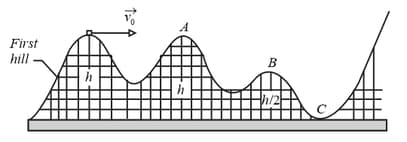


Important Questions on Potential Energy and Conservation of Energy
You drop a book to a friend who stands on the ground at distance below. Your friend's outstretched hands are at a distance above the ground (In the figure shown below).
(a) How much work does the gravitational force do on the book as it drops to her hands?
(b) What is the change in the gravitational potential energy of the book-Earth system during the drop? If the gravitational potential energy of that system is taken to be zero at ground level, what is (c) when the book is released and (d) when it reaches her hands?
Now, take to be at ground level and again find (e) (f) (g) at the release point and (h) at her hands.
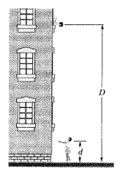
The figure shown below shows a ball with mass attached to the end of a thin rod with length and negligible mass. The other end of the rod is pivoted so that the ball can move in a vertical circle. The rod is held horizontally as shown and then given enough of a downward push to cause the ball to swing down and around and just reach the vertically up position, with zero speed there. How much work is done on the ball by the gravitational force from the initial point to,
(a) the lowest point, (b) the highest point and (c) the point on the right level with the initial point? If the gravitational potential energy of the ball-Earth system is taken to be zero at the initial point, what is it when the ball reaches (d) the lowest point, (e) the highest point and (f) the point on the right level with the initial point? (g) Suppose the rod was pushed harder so that the ball passed through the highest point with a nonzero speed. Would from the lowest point to the highest point then be greater than, less than, or the same as it was when the ball stopped at the highest point?
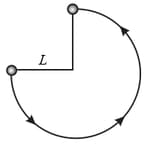
In the figure shown below, a ice flake is released from the edge of a hemispherical bowl whose radius is The flake-bowl contact is frictionless.
(a) How much work is done on the flake by the gravitational force during the flake's descent to the bottom of the bowl?
(b) What is the change in the potential energy of the flake-Earth system during that descent?
(c) If that potential energy is taken to be zero at the bottom of the bowl, what is its value when the flake is released?
(d) If instead, the potential energy is taken to be zero at the release point, what is its value when the flake reaches the bottom of the bowl?
(e) If the mass of the flake was doubled, would the magnitudes of the answers to (a) through (d) increase, decrease, or remain the same?
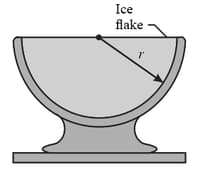
In the figure shown below, a small block of mass can slide along the frictionless loop-the-loop, with loop radius The block is released from rest at point at height above the bottom of the loop. How much work does the gravitational force do on the block as the block travels from point to (a) point and (b) the top of the loop? If the gravitational potential energy of the block-Earth system is taken to be zero at the bottom of the loop, what is the potential energy when the block is (c) at point , (d) at point and (e) at the top of the loop? (f) If, instead of merely being released, the block is given some initial speed downward along the track, do the answers to (a) through (e) increase, decrease, or remain the same?
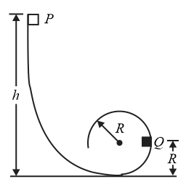
The figure shown below shows a thin rod of length and negligible mass, that can pivot about one end to rotate in a vertical circle. A ball of mass is attached to the other end. The rod is pulled aside to angle and released with an initial velocity As the ball descends to its lowest point,
(a) how much work does the gravitational force do on it?
(b) what is the change in the gravitational potential energy of the ball-Earth system?
(c) If the gravitational potential energy is taken to be zero at the lowest point, what is its value just as the ball is released?
(d) Do the magnitudes of the answers to (a) through (c) increase, decrease, or remain the same if the angle is increased?
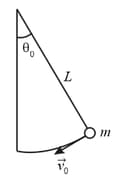
A snowball is fired from a cliff high. The snowball's initial velocity is , directed above the horizontal.
(a) How much work is done on the snowball by the gravitational force during its flight to the flat ground below the cliff?
(b) What is the change in the gravitational potential energy of the snowball-earth system during the flight?
(c) If that gravitational potential energy is taken to be zero at the height of the cliff, what is its value when the snowball reaches the ground?
In the figure shown below, a single frictionless roller-coaster car of mass tops the first hill with speed at height
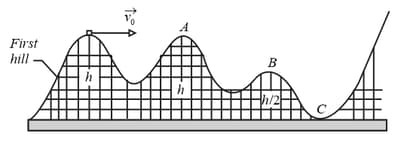
What is the speed of the car at (a) point , (b) point , and (c) point ? (d) How high will the car travel on the last hill, which is too high for it to cross? (e) If we substituted a second car with twice the mass. What then are the answers to parts (a) through (d)?
You drop a book to a friend who stands on the ground at distance below. Your friend's outstretched hands are at a distance above the ground (In the figure shown below).
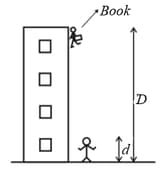
(a) What is the speed of the book when it reaches your friend's hands?
(b) If we substituted a second book with twice the mass, what would its speed be?
(c) If, instead, the book were thrown down, would the answer to part (a) increase, decrease, or remain the same?
